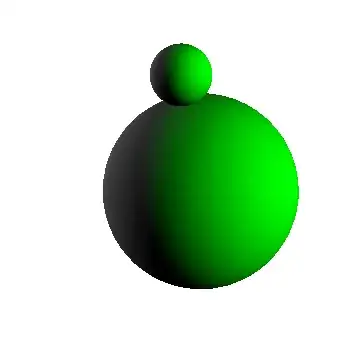We know that a simple application of Gauss's law tells us that the field inside of a uniformly charged spherical shell is zero. Does this hold for all uniformly charged closed surfaces? If so, how could we prove this? Or does it hold only for certain shapes?
3 Answers
It doesn't hold for arbitrary shapes.
The reason it works for spheres is that when you have a spherical charge distribution and a concentric spherical Gaussian surface, the whole system is invariant under rotations around the center of the spheres. If the electric field were different at different points on the Gaussian sphere, you could rotate the whole system around to interchange points at which the electric field is different, thus obtaining a completely different electric field configuration from the same physical system. But that's not allowed; there is a uniqueness theorem that guarantees that one physical system can only have one electric field. So the field must be the same all around the Gaussian sphere. (Similar reasoning shows that it must be perpendicular to the Gaussian surface at all points.)
You can then use those facts to simplify the integral in Gauss's law:
$$\iint_{\mathcal{S}} \vec{E}\cdot\mathrm{d}^2\vec{A} = E\iint_{\mathcal{S}} \mathrm{d}^2 A = EA$$
Knowing that the product $EA$ is equal to the enclosed charge, which is zero, and that the area is nonzero, the only option is that $E = 0$.
But if the surface and the system don't have that symmetry, you can't use that argument. The integral in Gauss's law can't be simplified any further than $\iint_{\mathcal{S}} \vec{E}\cdot\mathrm{d}^2\vec{A}$, and thus you can't use the above reasoning to conclude that $E = 0$. In particular, the electric field can be pointing inward at some points inside the surface and outward at other points, such that the total flux is zero and Gauss's law is still satisfied.
For example, consider a surface like this:

There can be an arbitrarily small hole at the point where the spheres touch, to make it one continuous surface. Anyway, the electric field from this surface inside the larger sphere will be the contribution from the larger sphere, which is zero, plus the contribution from the smaller sphere, which is not zero.
- 77,804
Let us ask the question the other way round. Given a conductor closed shape and a zero field inside, what are the possible surface charge distributions and when is one of them constant ?
The potential is solution of the Laplace equation and can written as $$V(r,\theta,\phi)=\sum_{\ell=0}^\infty \sum_{m=-\ell}^\ell \left(A_{\ell m}r^\ell+B_{\ell m}r^{-\ell-1}\right)Y_{\ell m}(\theta,\phi).$$ The constants $A_{\ell m}$ and $B_{\ell m}$ will take different values whether we are inside or outside the surface. We know that $V^{\text{out}}\to 0$ for $r\to\infty$ (so $A_{\ell m}^{\text{out}}=0$) and by hypothesis $A_{\ell m}^{\text{in}}=B_{\ell m}^{\text{in}}=0$ except $A_{00}=V_0$ is the value of the constant potential.
By continuity of the potential, we have therefore, for any point on the surface $$\sum_{\ell=0}^\infty B_{\ell m}^{\text{out}}r^{-\ell-1}Y_{\ell m}(\theta,\phi)=V_0.\tag{1}$$
The charge distribution at a point on the surface is given by $\sigma=-\varepsilon_0\hat{n}\cdot \nabla V$, where $\hat n$ is the normal unit vector to the surface. Only the term of the outside potential contribute. $$\sigma=\varepsilon_0\sum_{\ell=0}^\infty\sum_{m=-\ell}^\ell (\ell+1) B_{\ell m}^{\text{out}}r^{-\ell-2}Y_{\ell m}(\theta,\phi).\tag{2}$$
Equations (1) and (2) are expression of a constant function on the surface. Consequently there are proportionnal: there is a constant $\alpha$ such that $V_0=\alpha \sigma/\varepsilon_0$.
From a more fundamental point of view, equations (1) and (2) are implicit equations of the same surface written in the same coordinate system as $\Psi(r,\theta,\phi)=\text{constant}$, therefore the gradients of $\Psi$ taken for each of them must be colinear.
We can therefore write that, for all $\ell$ and $m$ $$ (\alpha(\ell+1)-r)B_{\ell m}=0,$$ which is possible if $B_{\ell m}=0$ or if $r$ is a constant. The case $r=\text{constant}=\alpha(\ell+1)$ is the known spherical case. We note that in the spherical case, there is only one possible value of $\ell$ for which $B_{\ell m}\neq 0$ and it is known that it must be $\ell=0$ from Gauss's theorem. So the only non trivial solution is $r=R=\text{constant}$. This gives the relation $\sigma=\varepsilon_0 V_0/R$. The total charge is $Q=4\pi\varepsilon_0V_0R$ and the potential in space is $V^{\text{out}}(r)=V_0R/r$.
- 1,989
For a convex surface, take any arbitrary point inside the closed surface. Now consider a cone with infinitesimal angle from that point so that it cuts the surface on both side.now you calculate the electric field for these infinitesimal surfaces say $\mathrm{d}s_1$ and $\mathrm{d}s_2$. You will find electric field as zero. as these two surfaces make same solid angle at the point but fields due to them are in opposite direction. $$\mathrm{d}E_1+ \mathrm{d}E_2 = \frac{(\sigma \mathrm{d}\vec{s}_1\cdot\hat{r}_1)}{r_1^2} (-\hat{r}_1)+\frac{(\sigma\mathrm{d}\vec{s}_2\cdot\hat{r}_2)}{r_2^2} (-\hat{r}_2)=\sigma \bigl(\mathrm{d}\omega(-)+d\omega(-)(-)\bigr)\hat{r}_1=0$$
as $\hat{r}_1=-\hat{r}_2$.
Similarly fill up the whole volume with such types of cones, you will get the result zero.
Note: I think, the proof is true only for a spherical surface where no concavity is present, as I have considered ${d}\vec{s}_1\cdot\hat{r}_1$ and ${d}\vec{s}_2\cdot\hat{r}_2$ forcefully instead of $d{s}_1$ and $d{s}_2$ respectively, to show same solid angle, as I had the misconception that the electric field inside any arbitrary shaped closed surfaces is zero. Even for sphere the above argument is true only for centre of the sphere. I somehow got confused with conductor case, where redistribution of charges is possible if we deform the surface. I request Jon to withdraw the acceptance of the answer as it doesn't answer his question properly.
For any arbitrary point inside the sphere, $$\mathrm{d}E_1+ \mathrm{d}E_2 = \frac{(\sigma \mathrm{d}\vec{s}_1\cdot\hat{r}_1)}{r_1^2 (\hat{n}_1\cdot\hat{r}_1)} (-\hat{r}_1)+\frac{(\sigma\mathrm{d}\vec{s}_2\cdot\hat{r}_2)}{r_2^2 (\hat{n}_2\cdot\hat{r}_2)} (-\hat{r}_2)=0$$ as $\hat{n}_1\cdot\hat{r}_1=\hat{n}_2\cdot\hat{r}_2$ $\ $ (related to the chord of a circle )
alemi has pointed out that the proof fails for non-convex surfaces, see his sketch:

- 1,366